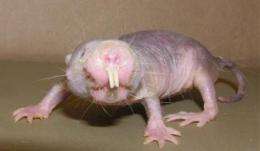Naked mole genome sequenced

Scientists have sequenced the complete genome of the naked mole rat, a pivotal step to understanding the animal's extraordinarily long life and good health. A colony of more than 2,000 naked mole rats at The University of Texas Health Science Center at San Antonio contributed to the findings, published today in the journal Nature.
"If we understand which genes are different or are expressed differently in naked mole rats — compared to short-lived mice that clearly have poor defenses against aging and cancer — we might find clues as to why the naked mole rat is able to extend both health span and longevity, as well as fight cancer, and this information could be directly relevant and translatable to humans," said Rochelle Buffenstein, Ph.D., professor of physiology at the Barshop Institute for Longevity and Aging Studies, part of the UT Health Science Center San Antonio. Dr. Buffenstein worked on the study with Thomas Park, Ph.D., of the University of Chicago; Vadim Gladyshev, Ph.D., of Harvard Medical School; the Beijing Genomics Institute; and other collaborators.
Rodent Methuselahs
The mouse-sized naked mole rat is the longest-lived rodent known, surviving up to 31 years in captivity. This is much longer than its laboratory rodent relatives, and the naked mole rat maintains good health and reproductive potential well into its third decade. Naked mole rats live underground in large family groups, like termites and bees, with only a single breeding female. These social rodents are extremely tolerant of life in low oxygen and high levels of carbon dioxide.
The naked mole rat's capacity to resist cancer and maintain protein integrity in the face of oxidative damage makes it an ideal animal model for aging and biomedical research, Dr. Buffenstein said. "Deciphering the animal's genetic blueprint is an important step to unlocking the keys to the naked mole rat's extraordinary longevity," she said. "This study reveals many of the genetic secrets to their extraordinary longevity, cancer resistance and pain tolerance, and their ability to survive in a low-oxygen environment. Indeed, having this animal's genetic blueprint is a treasure trove for many areas of biology and medicine because the genome will now be available to scientists everywhere to explore in their favored research area."
Barshop Institute Director Arlan Richardson, Ph.D., said: "The data in this Nature paper are very important for aging research because they give us the first glimpse into how the naked mole rat lives 10 times longer than its distant cousins, the mouse and rat."
Unusual appearance
Naked mole rats resemble pink, saber-toothed "sausages." Previous studies have yielded important insights into how the naked mole rat is able to rewire its brain (a process called neural plasticity), tolerate low oxygen and low body temperatures, and show cancer-free good health well into old age.
"Understanding their genomic footprint may reveal how they are able to maintain the integrity of their proteins and DNA far better than other animals do in old age, as well as how they mitigate the translation of oxidative damage into age-related declines and disease," Dr. Buffenstein said.
Provided by University of Texas Health Science Center at San Antonio















